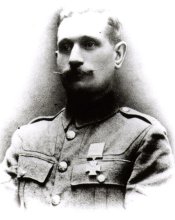Charles Jarvis (VC) facts for kids
Quick facts for kids
Charles Alfred Jarvis
|
|
|---|---|
 |
|
| Born | 29 March 1881 Fraserburgh, Aberdeenshire |
| Died | 19 November 1948 (aged 67) Dundee, Scotland |
| Buried |
Cupar Cemetery, Fife
|
| Allegiance | |
| Service/ |
|
| Years of service | 1899 - 1907, 1914 - 1917 |
| Rank | Corporal |
| Unit |
|
| Battles/wars | World War I |
| Awards | Victoria Cross |
Charles Alfred Jarvis was a brave Scottish soldier. He received the Victoria Cross (VC). This is the highest award for bravery in the face of the enemy. It is given to British and Commonwealth forces.
Jarvis was born in Fraserburgh, Scotland, on March 29, 1881. His father was also named Charles Alfred Jarvis and worked as a coastguard. Charles spent much of his early life in Carnoustie, where a memorial now honors him. Fraserburgh also honored him in 2014.
He joined the Royal Engineers in 1899. He traveled with his unit to Singapore. In 1907, he moved to the reserve forces. As a civilian, Jarvis worked with metal. He was also a member of an engineering society.
A Hero in World War I
When World War I began, Charles Jarvis was called back to serve. He was 33 years old. He was a lance-corporal in the 57th Field Company of the Royal Engineers. His amazing act of bravery earned him the Victoria Cross.
This happened early in the war, on August 23, 1914. It was in Jemappes, Belgium. Lance-Corporal Jarvis worked for 1½ hours under heavy enemy fire. He was in full view of the enemy soldiers. He successfully set off explosives to destroy a bridge. He was hurt while doing this brave deed. Another soldier, Private Samuel Heron, also received an award for his part in this action.
In 1915, Jarvis returned to Britain. He received his Victoria Cross medal at Buckingham Palace. He was later promoted to second corporal and then corporal. He left the Army in 1917. After the war, he worked at the Naval Dockyard in Portsmouth. He moved back to Dundee in 1941. Charles Alfred Jarvis passed away on November 19, 1948.
Early Life and Family
Soon after Charles was born, his family moved. His father was transferred to Rattray Head Coastguard Station. Charles went to school in Crimond for eight years. The family then moved to North Berwick. There, his father received a medal for bravely rescuing two boys. Later, his father was transferred to Carnoustie. Charles finished his schooling at Carnoustie School.
After leaving school, Charles started training to be a plumber. However, he could not finish his training. This was due to sad family events. He later found work as a metalworker.

